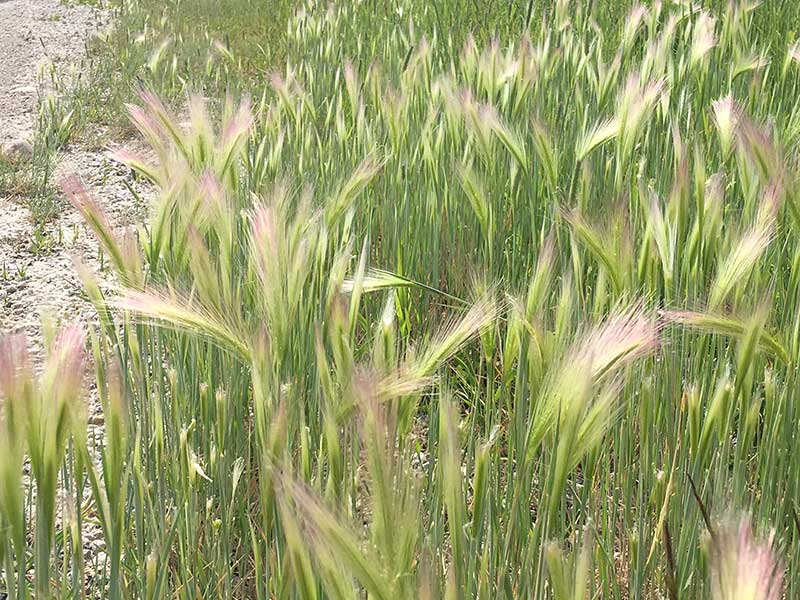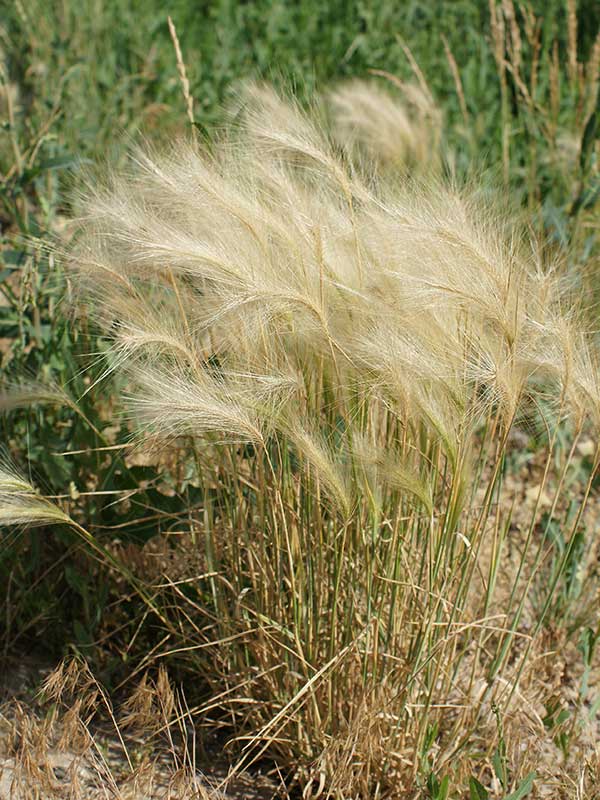Hordeum jubatum / foxtail barley
- attractive roadside grass
- long, silky, glistening awns; red, green, purple-ish
- awns and bracts are sharp and barbed… potentially dangerous to dogs
Also known as: bobtail barley, intermediate barley, squirreltail barley
Note: grasses have a nomenclature all their own, much different from that of dicots. A good resource/slide show from the University of Idaho on grass structures is available here.
Foxtail barley is a native perennial, bunchgrass. It is generally considered weedy, and is undesirable anywhere that grazers are likely to be found. On the other hand, as the gallery photos suggest, it is pretty enough to be planted as an ornamental. Its evolution is a bit unclear; it is polyploid and apparently arose as a hybrid between an East Asian species and an extinct relative of a Californian species, H. brachyantherum.
Foxtail barley is easily recognized and easily distinguished from other barley grasses (Hordeum spp.) by its nodding spikes and its long, silky, glistening awns. On each stem, there is a single, densely packed spike. Each spike is 2 to 4 inches long with a group of 3 spikelets (flower clusters) at each node. Each spikelet has a single floret. The spikes may be whitish green to red, to purplish at flowering time.
As the seeds mature, the spikelets turn tan and brittle. The bracts at the bases of the spikelets (glumes) curve outward as they dry, with the straight awns giving the cluster a spiky bottle-brush appearance. The entire group of 3 spikelets drops off when mature, leaving a naked stem behind. This clump of dried up spikelets including the seed can blow a long way, and is the way the species propagates.
Foxtail barley is cross-pollinated by wind-borne pollen. The pollen is considered a moderate allergen. The seeds are small… much smaller than agricultural barley. See the comparative photo in the gallery.
Besides the flowering heads, the leaves may also be “attractive”. Each is 2 to 6 inches long, up to ¼ inch wide, and green to blue-green or grey-green. The leaves and the sheath margins have numerous soft hairs.
Interesting bits – Having dealt with all the botanical aspects now, it’s time to say why this is also a terrible, horrible, no good, very bad plant! Basically, it’s because the awns and glumes, razor sharp needles in their own right, have numerous, sharp, backward-facing barbs. These help attach the seed clumps to, say, your dog’s coat. Or an elk’s, or any other animal. But they can also work their way through skin, and paw pads (or hoofs), ear canals, nasal cavities, tongues, lips and eyes. The barbs cause serious discomfort, and if they work their way deep enough, may require surgery to remove them. Without that, say for a pronghorn or deer, they can get infected and cause death.
So, while nursery sites may have lots of good things to say about the beauty of the flowering plants, most other sites have little good to say about it.
Beyond that, foxtail barley is known for its salinity (and drought, and flooding) tolerance. For that reason, and because cultivated barley is less so, it has been studied by physiologists trying to understand tolerance mechanisms. Also for that reason, it can be used for soil stabilization and mine spoil reclamation, especially in saline/alkaline areas where there are few other choices.
Otherwise, dense stands are associated with disturbances, e.g. overgrazing, excess mowing, creation of subdivisions. In the Valley, It is often seen along roadsides.



